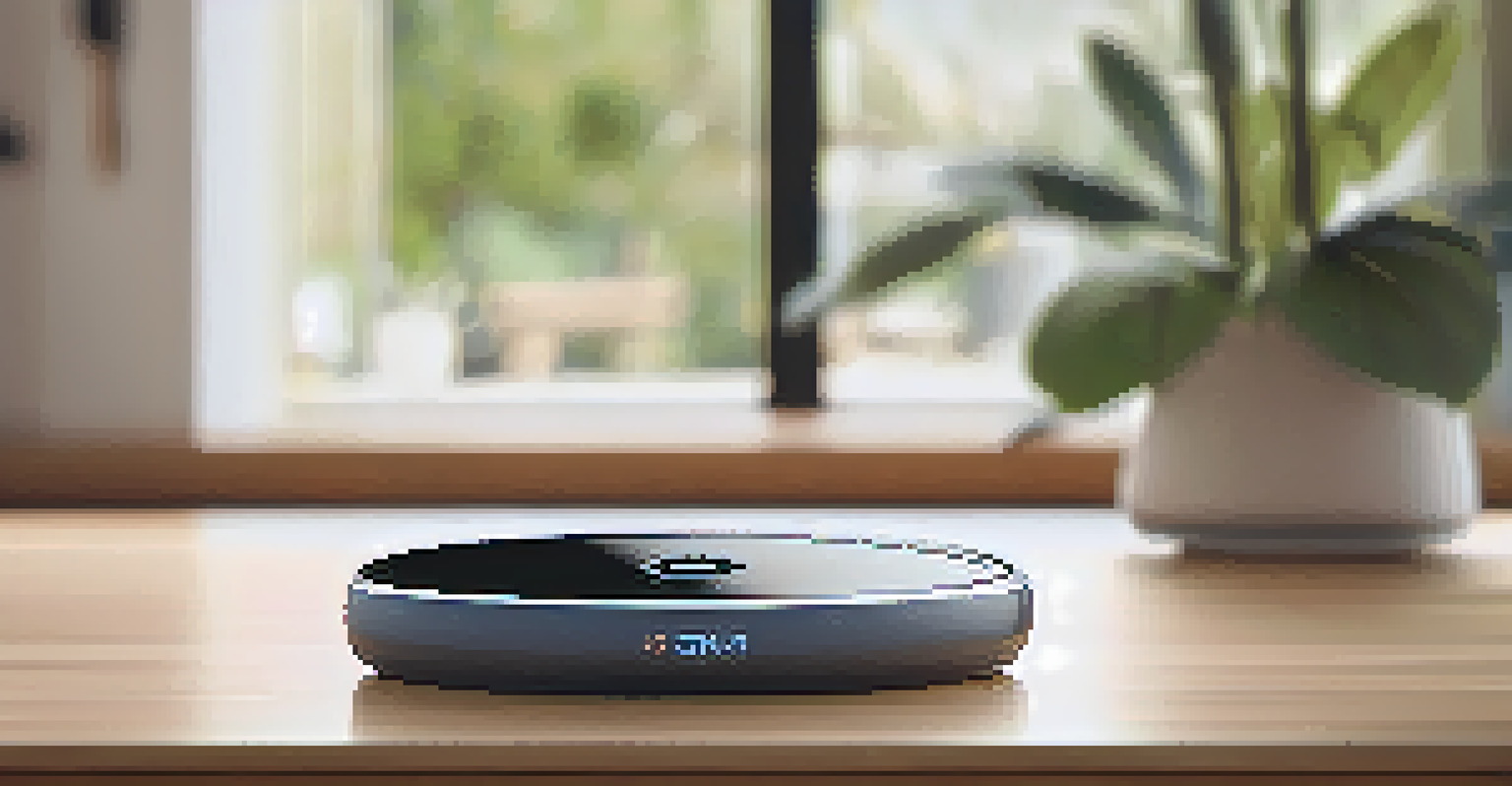Implementing Smart Sensors for Home Automation

Understanding Smart Sensors and Their Role
Smart sensors are devices that gather data about their environment and communicate it to other devices or systems. They play a crucial role in home automation by enabling intelligent responses based on environmental changes, such as light, temperature, and motion. For instance, a motion sensor can trigger lights to turn on when someone enters a room, enhancing both convenience and energy efficiency.
The real power of smart technology lies in its ability to seamlessly integrate into our lives, making everyday tasks easier and more efficient.
These sensors can be integrated into various home automation systems, allowing homeowners to monitor and control their living spaces remotely. Imagine being able to check if you left the porch light on or adjust the thermostat from your smartphone while at work. This level of control not only brings peace of mind but also contributes to a more sustainable lifestyle by optimizing energy use.
In essence, smart sensors act as the eyes and ears of your home, providing valuable data that can automate routine tasks. As technology continues to evolve, the capabilities of these sensors are expanding, making them more affordable and accessible for everyday consumers looking to enhance their living environments.
Types of Smart Sensors for Home Automation
There are several types of smart sensors that can be utilized for home automation, each serving a unique purpose. For example, temperature sensors help regulate heating and cooling systems, ensuring your home remains comfortable year-round. Similarly, light sensors adjust indoor lighting based on natural light levels, reducing energy consumption and enhancing ambiance.

Motion sensors are another popular choice, often used for security purposes, as they can detect movement and send alerts to your smartphone. These sensors can also be programmed to activate other devices, such as security cameras or alarms, providing an added layer of protection. With the right setup, your home can respond intelligently to any movement, giving you peace of mind.
Smart Sensors Enhance Home Automation
Smart sensors gather environmental data to automate tasks, improving convenience and energy efficiency in homes.
Lastly, water leak sensors can detect moisture in areas prone to leaks, such as basements or under sinks. Early detection can prevent costly damage and save homeowners from potential headaches. By incorporating various types of smart sensors, you can create a comprehensive home automation system that caters to your specific needs.
Benefits of Implementing Smart Sensors
Implementing smart sensors in your home offers numerous benefits, primarily enhanced convenience and comfort. Imagine coming home after a long day and having the lights turn on automatically as you enter, or the thermostat adjusting to your preferred temperature without you lifting a finger. These small yet significant improvements can greatly enhance your daily routine.
As we move towards a more connected world, smart sensors will play a pivotal role in transforming our homes into intuitive spaces.
Additionally, smart sensors contribute to energy efficiency, which can lead to cost savings over time. For instance, by using motion sensors to control lighting, you can ensure that lights are only on when needed. This not only reduces energy bills but also minimizes your carbon footprint, making your home more eco-friendly.
Moreover, the integration of smart sensors can significantly improve home security. With sensors monitoring for unusual activity, homeowners can receive real-time alerts and take action to protect their property. Whether it’s a burst pipe or an unwelcome visitor, smart sensors provide crucial information that empowers you to respond quickly.
Choosing the Right Smart Sensors for Your Home
When selecting smart sensors for your home, it’s important to consider your specific needs and lifestyle. Start by assessing the areas of your home that could benefit from automation—whether it's security, energy management, or convenience. This evaluation will help you prioritize which sensors to invest in first.
Compatibility is another key factor; ensure that the sensors you choose can easily integrate with your existing smart home ecosystem. Many sensors on the market today are designed to work with popular platforms like Google Home or Amazon Alexa, allowing for seamless control and automation. Reading product reviews and seeking recommendations can also provide insight into the best options available.
Variety of Sensors for Specific Needs
Different types of smart sensors, such as motion, temperature, and light sensors, cater to various home automation requirements.
Lastly, consider the installation process—some sensors are easy to set up and require no professional assistance, while others may necessitate expert installation. Weighing these factors will help you make informed decisions, ensuring that your home automation experience is both effective and enjoyable.
Integrating Smart Sensors with Home Automation Systems
Integrating smart sensors into your home automation system is essential for maximizing their potential. Most modern smart home systems allow for the easy addition of sensors, enabling them to work in harmony with other devices. For example, you can set up your sensors to trigger specific actions, such as adjusting the thermostat when no one is home or locking doors at a certain time.
One effective way to integrate these sensors is through the use of automation routines. These routines can simplify your life by creating a series of actions based on specific triggers. For instance, you can program your system to turn on outdoor lights at sunset when the light sensor detects falling brightness, creating a welcoming atmosphere without any manual effort.
The beauty of integration lies in the ability to customize your home automation experience. By experimenting with different sensor placements and settings, you can tailor your system to suit your preferences. This level of personalization not only enhances convenience but also allows you to create a truly smart home that adapts to your lifestyle.
Challenges of Smart Sensor Implementation
While the benefits of smart sensors are compelling, there are challenges to consider when implementing them in your home. One common issue is connectivity; smart sensors rely on a stable internet connection to function properly. If your home has Wi-Fi dead zones or unreliable service, it may hinder the performance of your sensors, leading to frustration.
Another challenge is the potential for false alarms, particularly with motion sensors. Pets, passing cars, or even trees swaying in the wind can trigger alerts, which can become bothersome over time. To mitigate this, it’s essential to choose high-quality sensors with adjustable sensitivity settings and strategically place them to minimize unnecessary activations.
Future Trends in Smart Sensors
Advancements in AI and 5G technology will lead to smarter, more responsive home automation systems that enhance user experiences.
Lastly, privacy concerns may arise when using smart sensors, especially those with cameras or microphones. Homeowners should educate themselves about data security and ensure their devices are from reputable manufacturers. By taking steps to protect your privacy, you can enjoy the convenience of smart sensors without compromising your personal information.
The Future of Smart Sensors in Home Automation
The future of smart sensors in home automation looks promising, with rapid advancements in technology on the horizon. As artificial intelligence (AI) continues to evolve, we can expect sensors to become even smarter, learning from user behavior and preferences to offer more personalized experiences. Imagine a system that anticipates your needs, adjusting settings based on your daily routine without any input.
Moreover, the integration of smart sensors with emerging technologies like 5G will enhance their capabilities. With faster data transmission, sensors can communicate in real-time, allowing for instant responses to changes in your home environment. This level of immediacy will significantly improve automation and security, making homes safer and more efficient.

As the market for smart home devices expands, we may also see increased affordability and accessibility of smart sensors. With more options available, homeowners will have the opportunity to experiment with various setups without breaking the bank. Ultimately, the future of home automation will likely be shaped by innovation, making smart living an integral part of our daily lives.